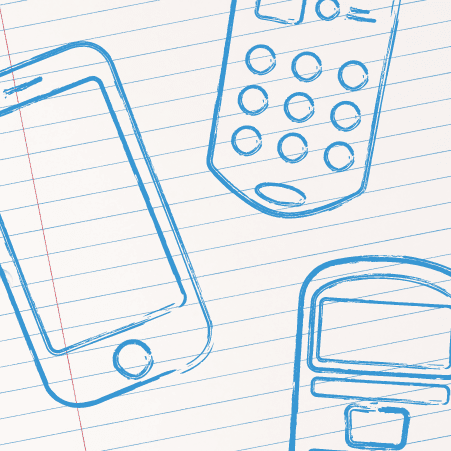Why your classroom response technology should offer clickers and smartphone solutions

According to the Pew Research Center, 94% of adults in the United States ages 18 to 29 own a smartphone. It is not surprising, then, that the debate over utilizing a classroom response system using cell phones and other types of electronic devices is as passionate as ever.
Just last year, a New York Times op-ed encouraging instructors to completely ban laptops and other electronic devices during lessons provoked numerous spirited responses ranging from enthusiastic agreement to vehement opposition. A study recently published in Educational Psychology asserting that in-class cell phone use results in lower test scores has prompted similar reactions.
Over the years, Echo360 Technologies has partnered with instructors whose opinions on this topic span the entire spectrum. Those experiences taught us an important lesson: A response solution that offers both clickers and mobile responding options serves the needs of everyone in ways that mobile-only systems cannot.
THERE IS CONTINUED DEMAND FOR CLICKERS
In 2018, 75% of Echo360Point sessions used only clickers, 13% used only mobile and 12% were hybrid (both mobile and clickers). This means that instructors used clickers in 87% of their sessions.
Despite the continuing growth in mobile usage, the data shows that most instructors are still more comfortable with clickers or prefer to offer students the option of using clickers. Accordingly, usage of response technology will be higher at institutions that support both clicker and mobile environments.

“Now I have the security of this device that allows for automated grading, but also really cuts down on opportunities to cheat.”
To accommodate the differing needs of instructors, Echo360 Technologies integrated both clicker and clicker on phone capabilities into its recently released Echo360Point web platform, possibly the only web product with native mobile and clicker support.
INSTRUCTORS WILL HAVE OPTIONS TO FIT EVERY NEED
The choice of whether to use clickers or mobile devices often hinges on both philosophical and practical factors that can differ significantly from one instructor to the next.
Meshagae Hunte-Brown, a teaching professor at Drexel University, uses Echo360Point to facilitate not only engagement, but also frequent testing in her large biology classes. This allows her to test students every week, rather than only a few times every semester.
Hunte-Brown does not let students respond with web-enabled devices, and instead requires them to purchase one of our full-featured clickers.
“There are mobile options, which I no longer use because I can’t have a student on a cell phone during a test,” she said. “Now I have the security of this device that allows for automated grading, but also really cuts down on opportunities to cheat.”
“Getting students engaged is the problem that is solved by using Echo360Point student polling.”
On the other end of the spectrum, Jim Mitroka, an associate professor of pharmaceutical sciences at Palm Beach Atlantic University, elected to use a fully mobile solution in his classes. This choice was primarily a matter of convenience, since students at the university’s Gregory School of Pharmacy already have tablets available to them.

Mitroka was less concerned with high-stakes testing, and more focused on engaging students in his classes with active learning approaches like the flipped classroom model. As he puts it, “Getting students engaged is the problem that is solved by using Echo360Point student polling.”
Finally, some instructors choose to empower the students themselves to decide which response option is best for them. Senior Lecturer in Music and Director of Learning and Teaching in the School of Arts at the University of Surrey Christopher Wiley, for example, always offers students the choice of using either the Echo360Point app or a clicker simply because “with the higher student fees, students cannot always be expected to own a smartphone.”
WHICH CLICKER SOLUTION IS BEST FOR YOU?
You should consider a number of factors when deciding whether to use mobile devices, clickers or both.
- IT infrastructure: First, consider the IT infrastructure where you will be running your polling sessions. Can the Wi-Fi network reliably handle simultaneous responses from hundreds of students? If not, clickers may be the way to go.
- Affordability: Cost is another significant factor to consider. As an initial step, standardizing on one response system acceptable to all instructors is the best way to save students money so students do not have to purchase multiple subscriptions or clickers.
- Access to web-enabled devices: Beyond that, do all of your students have smartphones or laptops? If not and you are interested in a mobile-only solution, do you have a plan to supply web-enabled devices to those students? (Echo360Point subscriptions include support for both mobile devices and clickers, and the incremental cost of an optional clicker is little more than an extra cup of coffee each year.)
- Faculty opinions: Finally, faculty opinions should be weighed carefully. If everyone agrees on using clickers on their phones or standard clickers, the choice is easy. If there are opposing views, then a hybrid option is an effective way to decrease conflict and increase usage, whether for simple engagement or high-stakes testing.
At the end of the day, every organization’s situation is unique, and its administrators and faculty members have to decide which response option is best for them. Clients are not shy about telling us what they want, and we have heard you loud and clear: A response system should not limit your choices, but instead provide the flexibility to support you and your organization’s needs, both today and into the future.
